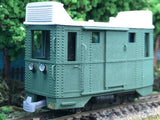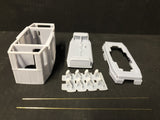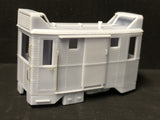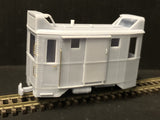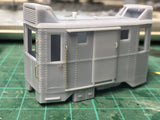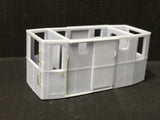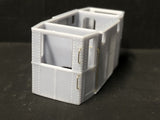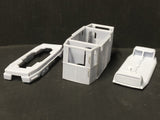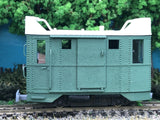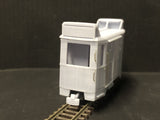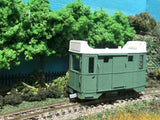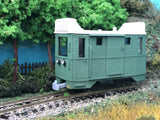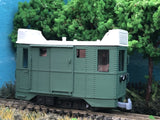Here is a Ganz Dmot loco taking inspiration from the Hungarian Ganz Dmot locos with some adjustments to fit the Kato chassis . The kit chassis is designed in such a way to clip easily onto a Kato 11-109 motor bogie chassis which can be carefully removed if you want to use it again on something else.
The body is also a simple drop fit onto the chassis to allow for painting prior to assembly and the roof is also separate to aid in painting and fitting the windows. Glazing is supplied pre-cut with protective film on both sides. Two pieces of brass wire and lamps are supplied and can be used to increase the realism of the kit if required.
This is a great kit to build although it does need some patience to fit the optional hand rails and lamps. Two pieces of brass are supplied that has to be cut and bent along with 8 lamps. I’m including extra lamps as they are quite small and I’ve even lost them while fitting them. We recommend either standard car primer or Tamiya primer as a base coat and finished with acrylic paints
We print our own models here in the UK using high detail resin. The sale is for the kit chassis, body, roof, glazing, brass wire and lamps. It also comes unpainted and the pictures showing the Kato chassis are for information purposes only, you will need provide your own one. See our shop for suitable motor chassis.
Finishing: All items are cleaned and cured by hand. They are unassembled and ready for you to prime and paint. We do our very best to remove support marks but some fine sanding may be required. All pieces and parts come unprimed and unpainted with all supports removed. Please do bear in mind that resin can be quite delicate so try to avoid dropping your parts! Sadly, we can't be held responsible for breakages once your item has arrived. However, if the piece is broken in the post, please provide images and we will of course see what we can do to
The origins of this railcar type can be traced back to the Kecskemét Commercial Railway, which required a new vehicle and consequently placed an order for two double-axle luggage railcars in 1935. The railway provided specific requirements: the vehicle had to be capable of hauling a 55-ton train over a distance of 50 kilometers (from Kecskemét to Kiskunmajsa) at a speed of 50 km/h, or a 110-ton train at a speed of up to 35 km/h. It had to cover this distance in a mere 130 minutes. Equipped with a VI JaR 135-185 diesel engine, which was suspended between the two driver's cabs in the luggage compartment on the chassis, the vehicle operated the two axles through a four-speed gearbox. These railcars, constructed with a dark green riveted steel frame, were completed in August 1935 and were adorned with a manufacturer's badge bearing the inscription GANZ.
The first vehicle, designated Mn1, underwent an official inspection on September 14, 1935, between Kecskemét and Kiskunmajsa, while the second vehicle's inspection took place a little later on October 5. The railcars of the Kecskemét Commercial Railway proved to be efficient in both passenger and freight transport, covering as many as 40,000 kilometers per year. Impressed by their performance, the company decided to procure additional railcars.













